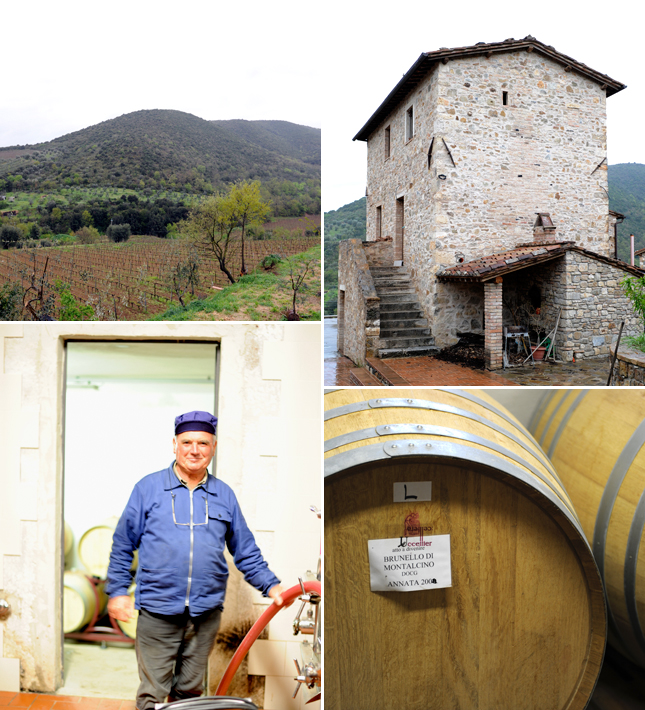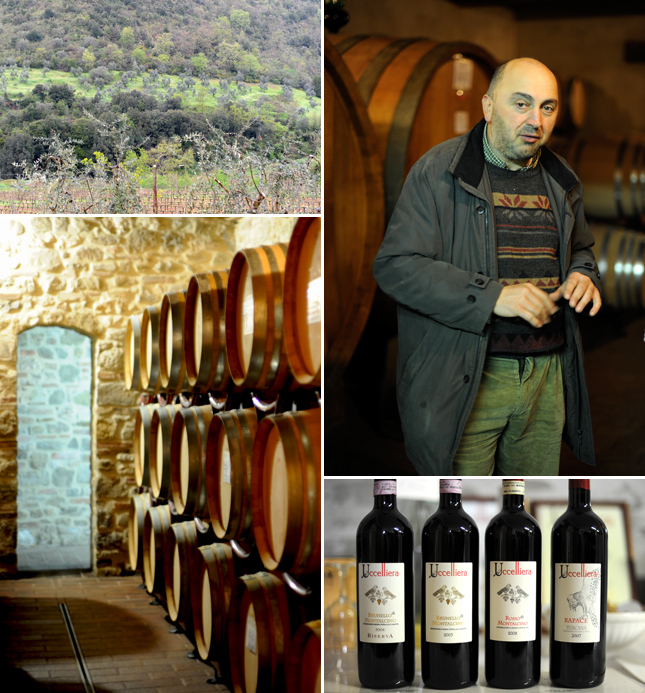Brunello di Montalcino

Field, 16th century facilities and cellar worker at Uccelliera
The little brown one — with such a cute moniker one might assume the wines to be dainty, delicate, even simple but Brunellos¹ are among some of the most intense, ageable and complex wines in the world. Professional wine tasters relish a chance to get their lips on a glass of old Brunello, collectors hoard the stuff and many are priced in a range only the most comfortable of household budgets can afford.
What makes Brunello one third of Italy’s killer “B”s — Barolo, Barbaresco being the other two — is its relatively miniscule production. While Italy leads the world in wine production the average annual output of Brunello di Montalcino is but a drop putting out only about 6.5 million bottles. This may seem like a lot but consider that in the neighboring region of Chianti Classico the average annual output is 40 million bottles. As director of the Consorzio del Vino Brunello di Montalcino, Stefano Campatelli describes Montalcino as, “An iceberg in an ocean of Chianti.”
Brunello is unique not just because of its scarcity. It is also a prized wine for its ageablity. One of the most esteemed names in all of winedom, Biondi-Santi, who has been making wine in the region since the 1880s is the winery that created the standards on which the Brunello D.O.C.G.² rules were written. A recent report regarding a tasting of the 1891 Biondi-Santi Riserva, exclaimed that all tasters were astounded to find the wine still so alive, vibrant and parfumed. How this is possible has to do with the uniqueness of the Sangiovese grown in the Montalcino area, the high acidity inherent in the grape and the meticulous winemaking methods practiced by most in the region. “The difference in Brunello di Montalcino and especially with Biondi-Santi,” said Franco Biondi-Santi, “is that we’re never in a rush.”

Winemaker and his product at Uccelliera
Newer producers adhere to the belief that time is needed to make great wine and in the case of Andrea Cortonesi of Uccelliera, great wine also takes enormous physical effort.
The largely self-taught Cortonesi purchased his vineyards in 1986 and after a few years of careful vine tending felt ready to produce his first vintage in 1991. “I learned by doing,” he explained, “so I worked the vineyards by hand with my father. I also went and worked harvests at other wineries to learn how others make their wines. Our first harvest was small and we made only 500 bottles. We started small but each year we learned what our vineyards could do and we learned what density to plant the vines. The next year we learned a little more and the next some more, and so on.”
Cortonesi continues to do everything by hand. From pruning to harvesting he is in the vineyard and winery overseeing every step of the production. The results of his efforts have earned him high marks in the world’s wine publications and the wines are now among some of the more pricy wines inside and outside of Italy. “It was great in the old days to be working out in the fields with my father, but that wasn’t feeding my family,” said Cortonesi. If one measures time using a Brunello clock, success came fairly quickly to Cortonesi and Uccelliera. A mere 20 years from their first vintage, not counting the six years he waited for his first release.
A little bit up the road is Cortonesi’s neighbor Laura Brunelli, winemaker and wife of the late Gianni Brunelli. Along with Brunello Laura makes some of the best “baby Brunello” or Rosso di Montalcino in the region. By law Rosso wines do not need to be aged as long as Brunellos and are thought of as interim wines as the Brunellos mature. She shares the same belief in the importance of time in wine making. “Now, in the spring” she explained, “is the only time we go fast. It is important now because of the rain and the sun. Overnight the vineyards grow. We have to work fast. It is also important now because the soil is soft on the hills. You respect the soil, to respect the ambience and atmosphere here. In doing this you respect the generations. All this work is for the balance. Here in the Montalcino, the wine is just as much an expression of the place as it is of the producer.” 
Stefano Campatelli, local product, Franco Biondi-Santi
1.) Brunello is made from the Sangiovese grape. In Tuscany it is also known as Sangioveto, Prugnolo Gentile and Morellino. According to D.O.C.G rules, a Brunello di Montalcino is always and only 100% Sangiovese. It must spend a minimum of 2 years in an oak barrel and 4 months (6 months for Riservas) in a bottle before release. Most producers extend barrel and bottle time. It is available for purchase 5 years after harvest (6 years for Riservas).
2.) About D.O.C. and D.O.C.G.
Denominazione di Orgine Controllata and Denominazione di Orgine Controllata e Garantita are the Italian wines laws that protect consumers and assure quality. These letters on the label denote that the wine is from a specific region and was produced following prescribed guidelines concerning percentages of blends and aging. There are 316 D.O.C.s and 37 D.O.C.G.s in Italy.
The Italian D.O.C.G. wines are distributed in 13 different regions as follows:
Piedmont: Barolo, Barbaresco, Brachetto d’Aqui, Asti, Ghemme, Roero, Dolcetto di Doglianico, Gattinara, Gavi
Lombardia: Franciacorta, Sforzato della Valtellina, Valtellina Superiore, Oltrepo’ Metodo Classico
Veneto: Recioto di Soave, Soave Superiore, Bardolino Superiore, Prosecco di Conegliano e Valdobbiadine
Friuli Venezia Giulia: Ramandolo, Picolit
Emilia Romagna: Albana di Romagna
Tuscany: Brunello, Chianti Classico, Chianti, Vino Nobile di Montepulciano, Vernaccia di San Gimignano, Morellino Scansano, Carmignano
Campania: Fiano, Taurasi, Greco
Abruzzo: Montepulciano d’Abruzzo
Umbria: Sagrantino di Montefalco, Torgiano Rosso Riserva
Marche: Rosso Conero Riserva, Vernaccia di Serra Petrone
Sicily: Cerasuolo di Vittoria
Sardegna: Vermentino di Gallura
D.O.C.G. wines are considered to represent the typicity of a region and of the fruit grown within that region. Wines of the Brunello di Montalcino became the first wines in Italy to earn D.O.C.G. status on July 1,1980.
* * * * *
To learn more about the wines mentioned in this story contact:
Tenuta “Greppo” di Franco Biondi-Santi
Montalcino, SI, Italia
Azienda Agricola Ucelleria
53024 Castelnuovo dell’Abate
Montalcino, SI Italia
Gianni Brunelli
Azienda Agricola Le Chiuse di Sotto Montalcino
Loc. Podernovone, 157
Montalcino, SI Italia






 Share Article
Share Article